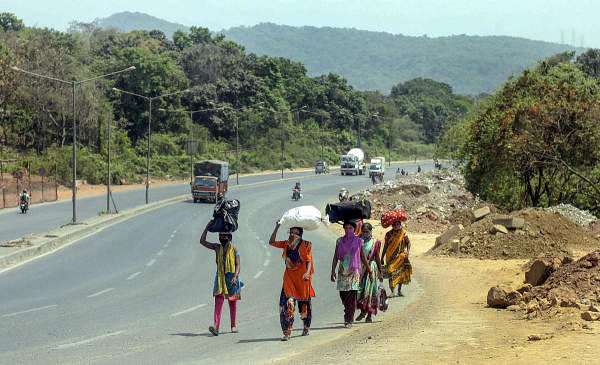
Munna, a migrant worker from Ballia, Uttar Pradesh, was one of the many millions of migrants stranded in India’s cities in the aftermath of the coronavirus lockdown. He, along with his wife and young children, were confined to their small factory unit in the outskirts of Gurugram, while their employer fled without paying them salary. Two days into the lockdown, the family barely had enough ration for one more day, having spent the past few days mostly on namkeens. They were dangerously nearing the brink of starvation.
Many of us are likely to believe that Munna’s family was doing just fine before the lockdown put them in unexpected crisis. A closer look tells us, however, that they were already on the edge, and the lockdown just successfully pushed them over. They were failed not by COVID-19 but by their existing, longstanding vulnerabilities -- one in which social and urban policy just glossed over their existence entirely.
For the migrants, the city has always been a site of extraction and alienation. Despite ‘building’ the city, they have persisted on its margins -- invisible and isolated. India’s urban policy imagination has been completely oblivious to their needs, struggling to recognise them as a legitimate presence in the city. In fact, it is this failure that has precipitated this exclusion into a large-scale humanitarian crisis for a population whose magnitude is estimated to be as large as 139 million (Economic Survey, 2017).
This urban exclusion has many stark manifestations.
According to a recent research study titled “Unlocking the Urban: Reimagining Migrant Lives in Cities Post-Covid-19”, undertaken by Aajeevika Bureau, about 95% of the migrants did not possess a ration card in the city and spent exorbitant amounts -- more than 50% of their incomes -- on securing food and fuel. While this has always been a harsh reality of their lives, the impact of this exclusion was compounded many times over in the wake of this current crisis when not possessing ration cards in cities meant a direct exclusion from the welfare schemes that were announced as part of the Covid-19 relief packages. Several distress calls from the communities we work with suggest that this exclusion has led to severe food insecurity in many migrant families.
The underlying structural issue that drives this exclusion is the huge ‘sedentary bias’ in our policies which mandates that every individual has to prove their domicile/residency status in the city to be eligible for a wide range of urban public entitlements. In a scenario where access to state services hinges on permanence of residence, migrant communities get excluded from the very scope of critical welfare benefits, including nutrition, healthcare, education and early childcare. For instance, our study revealed that for something as basic as immunisation, incentives for ASHA workers that encourage them to continuously vaccinate the same pregnant woman or child are hugely misaligned with the transient nature of the lives of migrant communities, with severe detrimental effects on the health and nutrition status of migrant children.
Another face of the migrants’ urban exclusion that was magnified during the Covid-19 lockdown is the absence of adequate and dignified shelter. Housed in informal, open settlements that are often unfairly labelled as ‘illegal’, in congested rented rooms in slums, or simply within the precarious confines of their worksites, a large majority of migrants persist in sub-human conditions in urban areas. In fact, the informality in their work arrangements gets faithfully replicated in the informality of their living conditions, all of it held together delicately by the common thread of indignity.
Enumeration eludes them at all levels, as administrative data by central, state or city governments do not capture migration flows in any meaningful way. Their settlements do not feature in city master plans; and their voices are unaccounted for in the urban planning processes, much like that of a large section of the urban poor in our country. For instance, an analysis of AMRUT (Atal Mission for Rejuvenation and Urban Transformation), a key policy on urban infrastructure development, reveals that critical decisions related to the establishment of water and sewerage lines in the city is based on Census data. Areas with a larger concentration of migrants, who remain excluded from the Census, thus remain unserved by a huge margin.
Welfare of this workforce also slips through the cracks between the systems of urban governance and labour governance. For instance, in recent years, many industrial areas that employ migrant workforce in large numbers are being established in urban peripheries, outside the purview of municipal corporations, thus largely outside the bounds of urban public services. At the same time, they also remain unregulated by the Labour Department that is heavily under-resourced, and by the legal provisions of important labour legislations.
Their work and living conditions are thus so informal and barely survival-level that in times of crises, the city offers them absolutely nothing to hold on to. Invisible and disenfranchised (with no voting rights in the city), their lives remain on the fringes of our urban policy imagination and their needs at the receiving end of a biased policy design.
Moving forward, the public and policy attention to the anguish faced by migrants should be leveraged to enable them to stake stronger claims to basic public services in the city. Enumeration and recognition of their living spaces by including them purposefully into the ambit of urban governance will go a long way in honouring their rights as legitimate citizens. The need of the hour is to reimagine the migrants’ relationship to the city and reward them with rights and dignity, befitting the enormous contributions they make to fuel the engines of our urban spaces.
(The writer leads policy research and advocacy at Aajeevika Bureau, a public service initiative to provide security and dignity to communities dependent on migration across Rajasthan, Gujarat and Maharashtra)